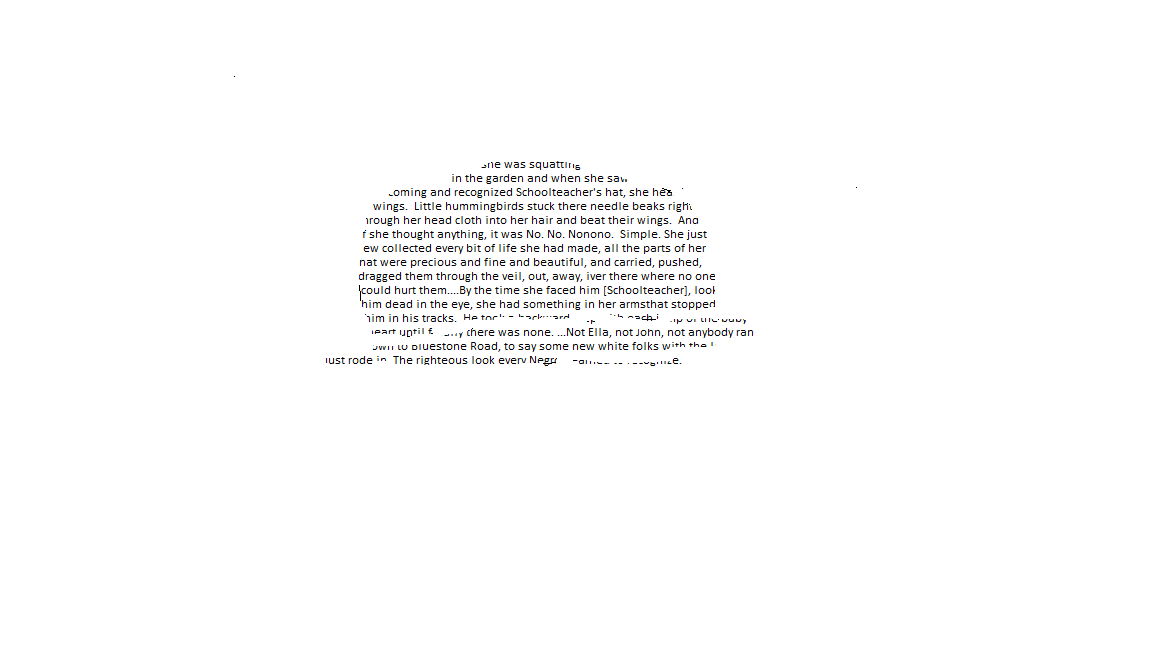Beloved by Toni Morrison is a novel about Sethe’s life and how her past comes back to haunt her in many ways. Sethe as a person has endured many forms of suffering during her slave years. Throughout the story, we see many scenes that contribute highly to the storyline itself. These scenes may even bring up a symbol that will be brought up to the end of the story. Going back to Sethe’s suffering, we see one form of suffering that really carried on throughout the story. That suffering is the moment her milk was stolen from her. Milk played a huge symbol in this story and without the scene that brought up this major symbol, this story would probably be completely different.
The scene I’d like to bring up is a scene that happened in the beginning of the book. On Chapter 1 Page 19 (Red Book), we see a scene that shows the suffering that Sethe withstood. Although a flashback, we hear what happened to Sethe after running away.
“After I left you, those boys came in there and took my milk. That’s what they came here for. Held me down and took it. I told Mrs. Garner on em. She had that lump and couldn’t speak but her eyes rolled out tears.”
To simplify this, Sethe was beaten down by schoolteacher’s nephews and her breast milk was forced from her. This flashback is very important because it starts off the whole milk topic in the story. After reading this, we also see that Sethe was treated poorly and inhumane. In other words, she was treated as a cow and not as a human being. This scene is very important and without it, the story would be different. Sethe’s mindset would be different compared to what we read. Events that flashback to this milk scene would not have happened as well. This scene also brings up the topic of her suffering and how that suffering scarred her. Lastly, as I mentioned before, this scene was a starter that brought about a chain reaction throughout the rest of the story.
Moving on, we go further into the story. The time milk was taken from Sethe by the nephew of school teacher still lingered in the mind of Sethe. It was very traumatizing for her, and with that, I now bring up a scene in Chapter 7 Page 83 (Red Book) of the story.
“There is also my husband squatting by the chum smearing the butter as well as its clabber all over his face because the milk they took is on his mind. And as far as he is concerned, the world may as well know it. and if he was broken then, then he is also and certainly dead now.”
In other words, the incident where milk was taken from Sethe was very traumatizing to not only her but to her husband Halle as well. It was something that both of them couldn’t even take off their minds. It wouldn’t be surprising if many people knew about this incident. This incident put unwanted thoughts in Halle’s mind and he became a Halle we didn’t even know. The single thought of this incident drove him insane. Unfortunately, Halle was never seen again after the butter incident which of course would hit Sethe, his wife at the time, pretty hard. After reading this, we can already assume that Halle is dead. The thought of being a widow is something that she couldn’t really take. This stuck to her even after leaving Sweet Home. This scene is one of those pivotal scenes that resulted from the milk incident because without Halle’s disappearance, Sethe wouldn’t have had a broken heart. She wouldn’t have also recalled this scene many times after thinking about Halle. This scene also enabled Sethe to grow. If it wasn’t for Halle’s disappearance, Sethe wouldn’t have moved on to start rebuilding her family from scratch with Paul D. Going back to the original milk robbing scene, if that scene hadn’t happened, the scene discussed on this paragraph would have not happened which essentially is a novel changing scene.
Later on in the story, we see a Sethe that is more caring towards everyone especially Beloved and Denver. She loved her children which is her duty as a mother. She wanted to give whatever she had to her baby however, we saw earlier in the book that her milk was taken from her which scarred her. This however didn’t stop her from wanting to provide love for her loved ones. This brings up our next quote which can be found on Chapter 8 Page 118 (Red Book).
“There was no question but that she could do it. Just like the day she arrived at 124-sure enough, she had milk enough for all.”
To restate this, there was without a doubt that she could provide for her children. Sethe wanted to provide for her children. Regardless of what happened and what could happen, she wanted to give no matter what. Based on this, we can probably see a development in an obsession towards this one goal. Now what exactly does this have to do with the scene we read on Page 19 (Red Book)? The answer to that is we can see that she shows signs of growth and development since the day her milk was taken from her. She prepared herself to give up everything just to provide her children with her nutrients.
Now I would like to mention other events that happened as a result of the milk incident. As we know, Paul A, Sixo are nowhere to be found. This is because they are dead. The milk scene contributed to their deaths because they died right after Mrs. Garner was notified about the attack. As a result, schoolteacher found out about the grand escape and proceeded to execute them. Another event in the story that resulted in the milk incident was the birth of Denver with the help of Amy Denver. During the escape, an injured Sethe was ready to give birth to Denver. However, Amy Denver found her and proceeded to help out with the delivery thus starting out their trustworthy friendship. The last event I’d like to bring out is the murder of Beloved. The thought of slavery stained Sethe’s mind. She had children and she absolutely did not want to go back and have them deal with it too. Sethe didn’t want her children to be treated like animals and she did not want them to be beaten. As a result, she attempts to kill them but only killing one in the process which we can assume is Beloved.
In conclusion, that one scene from Page 19 (Red Book) played a very important role in the story. The reason why I titled this “Transforming Milk” is because this event transformed Sethe and how the story played out. It enabled Sethe character to grow as a woman and not as the cow she was depicted as during her years as a slave. This scene resulted in many crucial events leading to the end of the story. If the milk scene hadn’t happened, Halle wouldn’t have died, Sethe wouldn’t have grown, Paul A and Sixo wouldn’t have died, Denver wouldn’t have been born properly, and lastly, Sethe wouldn’t have had to kill Beloved. All these events were results from Sethe’s beatdown/robbery. If Sethe wasn’t robbed and beat, these scenes wouldn’t have happened and we would see a completely different, probably more happier story.







